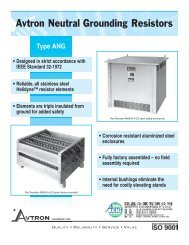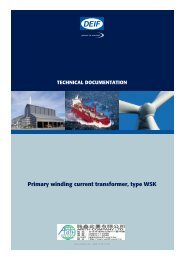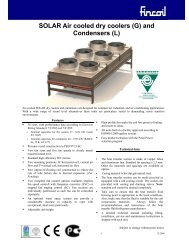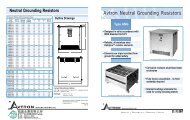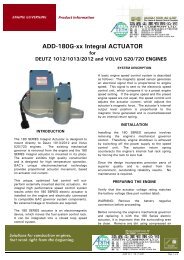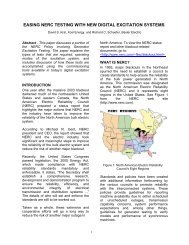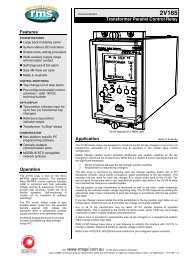ENGINE GOVERNING SYSTEMS LSM672 LOAD SHARING MODULE
ENGINE GOVERNING SYSTEMS LSM672 LOAD SHARING MODULE
ENGINE GOVERNING SYSTEMS LSM672 LOAD SHARING MODULE
Create successful ePaper yourself
Turn your PDF publications into a flip-book with our unique Google optimized e-Paper software.
<strong>ENGINE</strong><strong>GOVERNING</strong><strong>SYSTEMS</strong><strong>LSM672</strong><strong>LOAD</strong> <strong>SHARING</strong> <strong>MODULE</strong>MEMBERGOVERNORS AMERICA CORP. • 720 Silver Street • Agawam, MA 01001-2907, USA
SPECIFICATIONSPERFORMANCELoad Sharing . . . . . . . . . . . . . . . . . . . . . . . . . . . . . . . . . . . . . . . . . . . . . . . Adjustable to within ±2% between setsPerformance . . . . . . . . . . . . . . . . . . . . . . . . . . . . . . . . . . . . Isochronous and droop paralleling and power controlReverse Power Monitor . . . . . . . . . . . . . . . . . . . . Adjustable from 0.5-20% with a 2 second inverse time constantForward Power Monitor . . . . . . . . . . . . . . . . . . . . . . . . . . . . . . . . . . . . . . “ON” trip point adjustable from 20-100%“OFF” trip point adjustable from 0-80%Normally open contacts with a 2 second inverse time constantPower Output Signal . . . . . . . . . . . . . . . . . . . . . . . . . . . . . . . . . . . . . 0 to 7.5 Volts DC representing 0-100%’IoadAll performance specifications are based on 5 amps from the current transformer (CT) secondaries at full load unity P.F.POWER INPUTAC Input Signals . . . . . . . . . . 208 or 416 Volt nominal line to line and 5 Amp CTs with a minimum 6.25 VA rating.. . . . . . . . . . . . . . . . . . . . . . . . . . . . . . . . . . . . . . . . . . . . . . . . . . . . . . . . . . . . . Internal 0.25 ohm burden resistorsLine to Line Voltages . . . . . . . . . . . . . . . . . . . . . . . . . . . . . . . . . . . . . . . . . . . . . . . . . . . . . . . . . . . per table belowHZ LOW RANGE HIGH RANGE50 140-250 VAC 260-420 VAC60 170-260 VAC 340-500 VAC400 170-260 VAC 340-500 VACDC Supply . . . . . . . . . . . . . . . . . . . . . . . . . . . . . . . . . . . . . 18 - 36 VDC (Transient and reverse voltage protected)For 12 VDC applications use LSM 672-12Polarity . . . . . . . . . . . . . . . . . . . . . . . . . . . . . . . . . . . . . . . . . . . . . . . . . . . . . . . . Negative ground (case isolated)DC Power Consumption . . . . . . . . . . . . . . . . . . . . . . . . . . . . . . . . . . . . . . . . . . . . . . . . . . . . . . 70 ma continuousPower Output Signal . . . . . . . . . . . . . . . . . . . . . . . . . . . . . . . . . . . . . . 0 - 7 Volts based on 5 amps of C.T. outputENVIRONMENTALTemperature Range . . . . . . . . . . . . . . . . . . . . . . . . . . . . . . . . . . . . . . . . . . . . 40º F to + 175º F (-40º C to +80º C)Relative Humidity . . . . . . . . . . . . . . . . . . . . . . . . . . . . . . . . . . . . . . 100% - Circuit board heavily conformal coatedAll Surface Finishes . . . . . . . . . . . . . . . . . . . . . . . . . . . . . . . . . . . . . . . . . . . Fungus proof and corrosion resistantPHYSICALDimensions . . . . . . . . . . . . . . . . . . . . . . . . . . . . . . . . . . . . . . . . . . . . . . . . . . . . . . . . . . . . . . . . . . See Diagram 1Weight . . . . . . . . . . . . . . . . . . . . . . . . . . . . . . . . . . . . . . . . . . . . . . . . . . . . . . . . . . . . . . . . . . 5.2 Lbs. (2.36 Kgs)Mounting . . . . . . . . . . . . . . . . . . . . . . . . . . . . . . . . . . . . . . . . . . . . . . . . . . . . . . . . Any position, vertical preferredRELIABILITYTesting . . . . . . . . . . . . . . . . . . . . . . . . . . . . . . . . . . . . . . . . . . . . . . . . . . . . . . . . . . . . . . . 100% Functional testedVibration . . . . . . . . . . . . . . . . . . . . . . . . . . . . . . . . . . . . . . . . . . . . . . . . . . . . . . . . . . . . . . . . . . 1 g @ 20-100 HzShock . . . . . . . . . . . . . . . . . . . . . . . . . . . . . . . . . . . . . . . . . . . . . . . . . . . . . . . . . . . . . . . . . . . . . . . . . . . . . . 10 gsSpecial VersionsLSM 672-C . . . . . . . . . . . . . . . . . . . . . . . . . . . . . . . . AC VOLTAGE INPUT NOMINALLY 120 VAC LINE TO LINELSM 672A-1 . . . . . . . . . . . . . . . . TERMINAL 25, POWER OUTPUT SIGNAL WITH RESPECT TO TERMINAL 16(TERMINAL 16 FUNCTION DISABLED) OUTPUT= 0 to 7 VDC FORWARDPOWER AND 0 to -2 VDC REVERSE POWER.LSM 672-1 . . . . . . . . . . . . . . . . . . . . . . FOR MAINS POWER CONTROL OPERATION. See publication PT14003INSTALLATIONThe unit is typically mounted in the generator set controlcabinet with the other dedicated control equipment.Position the unit so that the natural flow of cooling air isnot obstructed. The unit’s three large burden resistors willdissipate up to 6.25 watts each.WIRINGElectrical connections are illustrated in Diagram 2. Choiceof the proper wire size is dependent on the maximum currentexpected at specific terminals of the load sharing module.Terminals 7-12 can reach a maximum of 5 amps. Allothers are less than 50 ma, with the exception of the relaycontacts which are rated up to 10 Amps.Terminal N is the neutral connection for a 3 phase voltage,“Wye,” configuration generator.-3-
Diagram 1. SYSTEM WIRING/OUTLINE-4-
Terminals 1-6 accept for the 3 PHASE VOLTAGE inputs.Selection of the proper 3 terminals is dependent on thegenerator voltage. See Specification, page 2.CAUTION.HIGH VOLTAGE PRESENTAT TERMINALS N & 1-6TERMINAL STRIP COVER MUSTBE IN PLACE WHEN IN OPERATIONTerminals 7-12 accepts the 3 PHASE CURRENT input from5 amp current transformers. Series connections can bemade from instrument panel CTs providing the VA rating isadequate. The CT burden of the load sharing module is6.25 VA for each phase. This will add to the burden rate ofthe panel instruments and wiring on the CTs. Note the commonCT connections at terminals 8,10 and 12. This isrequired for CE approved applications.Terminals 13 and 14 are the PARALLEL CABLE connectionswhich link all load sharing modules together. Properpolarity must be observed. If these cables are longer than3 ft. (1 m) they must be shielded with the shield groundedat Terminal 23. The relay contacts used must be suitable forlow current levels, < 1 ma (Dry contacts).Terminal 15 is the load sharing OUTPUT TERMINAL to thegovernor system speed control unit. If this cable connectionis longer than 3 ft (1 m), it must be shielded. Ground theshield at Terminal 23.Terminal 16 is the FORWARD POWER RESET A momentaryconnection to a +10 VDC source on the governorspeed control using a normally open switch will automaticallyreset the forward power relay to the OFF condition.Connecting Terminal 16 to battery negative turns on themonitor. The forward power monitor may also have programmedswitch points through Terminal 16. Connecting a1 megaohm resistor between Terminal 16 and batteryminus (terminal 23) shifts a 100% ON/40% OFF settingdown to a 85% ON/5% OFF setting. If different programmingis required, consult GAC’s engineering for assistance.Terminals 17 and 18 are for a REVERSE POWER RESETmomentary switch. The unit is factory shipped with ajumper connected, for automatic reset. This automaticreset will cause the internal relay will remain energized onlywhen the reverse power level is above the reverse powerset point.The reverse power relay can be setup to latch and then bemanually reset by an external switch at terminals 17 to 18with the following modification. Install a soldered wire linkbetween posts E4 and E5 on the circuit board. The postsare accessible by removing the unit’s cover. See Diagram1 for post positions.Replace the factory installed jumper between Terminals 17and 18 with a N.C. momentary switch. The reverse powerrelay and sensing circuit will reset to the OFF conditionwhen switch is opened.Terminals 19 and 20 are the REVERSE POWER RELAYOUTPUT TERMINALS. Contacts are N.O. and rated for10 amps (LED lights).Terminals 21 and 22 are the FORWARD POWER RELAYOUTPUT TERMINALS. Contacts are N.O. and rated for10 amps (LED lights).Terminal 23 is the battery negative connection and is connectedto the ground reference terminal at the control unit.Do Not connect directly to battery minus or a ground loopwill be formed.Terminal 24 is connected to the positive side of a 24 voltbattery supply.Terminal 25 provides a D.C. voltage proportional to thepower output of the generator set. Ground reference isTerminal 23. Further information may be found in the sectionon the Power Output Signal.PRE-PARALLELING CHECKS1. Load Sharing Sensitivity adjustment — Full clockwiseposition.2. Load Anticipation adjustment — 1/4 turn from full counterclockwise(OFF) position.3. Governor Speed Set point — trim to desired speedsetting.4. CT Phasing check requires DC voltage measurements.Measure across the test posts (TP1 and TP2) observinginstrument polarity, TP1, the lower post, is (+). This voltageis directly proportional to unity P.F. load. A voltage of0 to 7.5 VDC can be expected, depending on load, LoadSharing Sensitivity adjustment, and CT ratios.With the generator set under load, check the CT phasingmomentarily and sequentially short each CT one at a time,with an insulated lead at Terminals 7-8, 9-10, or 11-12.Each time a CT is independently shorted, the voltagereading will be reduced by 1/3. If the voltage change is not1/3, this very likely indicates improper CT or voltage phasing.Corrections to CT phasing must be performed whilethe generator set is not running.CAUTIONDO NOT OPEN CIRCUIT CT CONNECTIONSWHILE THE GENERATOR SET IS RUNNING,HIGH VOLTAGE WILL BE PRESENT.INSURE TO REPLACE, TERMINAL BLOCKCOVER AFTER ALL WIRING IS COMPLETED.ADJUSTMENTSWith the generator paralleled to the other generator(s)and with no load on the system, adjust each generatorsspeed setting using the governor speed trim control forzero power as indicated on each generator sets wattmeterand proper system frequency (50,60 or 400 Hz). Also,adjust the generators AC voltage regulators setting forzero circulating AC current. Electrical load can now beapplied to the system.-5-
Load SharingAll generator sets in the system should be sharing the systemload proportionately. The generator set carrying lessthan its share of the load should be adjusted to acceptmore of the system load. Move the appropriate <strong>LOAD</strong><strong>SHARING</strong> SENSITIVITY adjustment counterclockwise toincrease its contribution of load.Load Anticipation<strong>LOAD</strong> ANTICIPATION adjustment is factory set at 1/4 turnfrom full counterclockwise. To improve transient response,gradually advance the adjustment clockwise while theengine generator sets are in parallel. The transientresponse improvement can be observed with engine loadchanges. Instability may result if the adjustment isadvanced too far clockwise. A conservative adjustment issuggested.DroopDroop operation may be required under certain circumstances.To obtain droop, disconnect the parallel cableconnections from Terminals 13 and 14. Place a jumperbetween Terminals 13 and 14. Turn the <strong>LOAD</strong> <strong>SHARING</strong>SENSITIVITY adjustment clockwise to increase the percentageof droop. Or connect a 100K variable resistoracross the open parallel cable terminals 13 and 14.Adjustable droop of about 5% can be obtained. See thePower Control Bulletins for further information on droopoperation.Slowly raise the engine generator set load to the desired “ON”forward power relay trip point. Rotate the “ON” adjustmentcounterclockwise until the forward power LED lights and therelay energizes. Slowly reduce the engine load to the desired“OFF” forward power relay trip point. Rotate the “OFF” adjustmentCCW until the forward power LED extinguishes and therelay de-energizes.Adding a 10 mfd capacitor between posts E6 and E7 (+) doublesthe inverse time constant to 4 seconds.The load percentages referred to are based on a 5 Amp CTsecondary current at full engine load and are approximate.POWER OUTPUT SIGNALA DC signal proportional to the power measured is availableat Terminal 25. The voltage range is 0 to 7.5 VDC based on a0 to 5 Amp CT current range. The impedance of Terminal 25is 1 K ohms and Terminal 23 is the ground reference. This outputis a voltage based signal.This signal may be used to drive a 0-1 MA meter movement ifthe meter and a 10K ohm calibration potentiometer are connectedin series between Terminal 25 and 23.Reverse PowerReverse Power monitor adjustment is factory set at fullclockwise for the highest trip point setting. Adjust theReverse Power monitor counterclockwise to set thereverse power relay trip point. The range of this adjustmentis 0.5% to 20% based on 5 Amp CT secondary output. Withthe desired level of real or simulated reverse power appliedto the generator, set the reverse power relay trip point.Note: Reversing the polarity connections of each CT andthen applying normal electric load simulates a reversepower condition. After adjustment, correctly replace all CTconnections.If a longer inverse time constant is desired, add a 10 mfdcapacitor to posts E3 and E4 (+). This doubles the timeconstant, making it approximately 4 seconds.Forward PowerThe Forward Power Monitor is typically used as an actionsignal for an additional engine to start when the powerdemand increases or to signal an engine to shut off whenthe power demand is reduced.The Forward Power monitor “ON” adjustment is factory setfull clockwise (>100%). The Forward Power monitor “OFF”adjustment is factory set full counterclockwise (
SYSTEM TROUBLESHOOTING1.0 Reconfirm the 3 phase AC Voltages are present andwithin specification. Also confirm that a neutral connectionto the generator has been made.2.0 With DC applied to terminals 23 and 24, measurethe units output voltage from terminals 15 and 23.This should be 5.0 VDC ± 0.1 VDC.3.0 Measure the parallel cables voltages at No Load.13 to 14 Nominally 0 VDC ±- .05 VDC13 to 23 Nominally 5.0 VDC14 to 23 Nominally 5.0 VDC4.0 Recheck the CT phasing. Measuring the AC voltageacross each CT input will also confirm equal CT currents.5.0 If instability is present when the generator sets are inparallel, equally reduce the Load Sharing Sensitivityadjustment of each load sharing module. Rotate theadjustments in small increments counterclockwiseon all of the load sharing modules in the system untilstability is restored. If the Load Sharing Sensitivityadjustment is reduced to less than 25%, poor loadsharing may result. Further check to insure that theLoad Anticipation adjustment is at the factory settingof 1/4 turn from full counterclockwise.6.0 If the instability still persists, open the parallel cableand add a jumper across the parallel cable connection,Terminals 13 and 14, of each unit. Droop will bepresent, but the system should be stable. If not,check the generator voltage regulator stability.SPECIAL APPLICATIONSIn addition to load sharing, the <strong>LSM672</strong> is capable of generatorpower control and main bus power management.Request the applicable publication.PT14003 Mains Incoming Power ControlThe <strong>LSM672</strong> can monitor a main bus and signal the generatorsto adjust their contribution to the system load tohold constant or limit the mains power.PT14040 Using the Power Ramp ControlThe PRC100A Power Ramp Control from GAC can beused to ramp the generator load. Import and/or Export control,or individual generator control can be achieved withthe PRC100A to smoothly ramp the generator(s) on or offthe main bus.Internal Post FunctionsPost E1 and E2 may be connected with a jumper to convertto the 3.1 V reference used by some competitive governorsystems.Post E8 allows checking of the 5.1V reference supply.Post E9, E10, E11 and E12 are used to invert the signal ofthe output circuit. The normal configuration is for E9 andE10 to be jumpered and for E11 and E12 to be jumpered.Peak Shaving (<strong>LSM672</strong>-1)For peak shaving applications, remove the E9 to E10 andE11 to E12 jumper wires. Install a jumper wire betweenposts E9 and E11. Install a 42.2K ohm resistor betweenposts E10 and E12. The unit is now an <strong>LSM672</strong>-1. Refer toPTI 4003 for application instructions.REFERENCE ADJUSTMENT CALIBRATIONTo adjust and calibrate the internal reference bias, applyDC and AC voltages to the LSM 672. At no load, removeTerminal 15 to the speed control unit. Measure Terminals15 and 23. Adjust this voltage for 5.0 VDC.PT14002 Generator Power ControlAn <strong>LSM672</strong> may be used to control the generation of powerfrom engines tied to a main bus. A simple manual adjustmentsets all engines to deliver constant power to a mainbus.-7-



